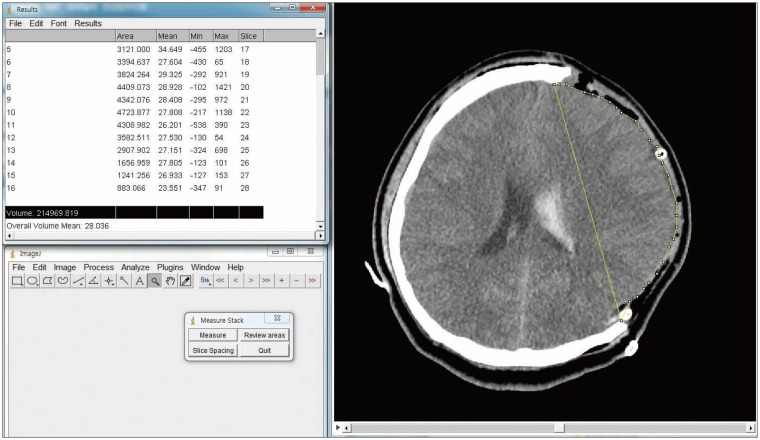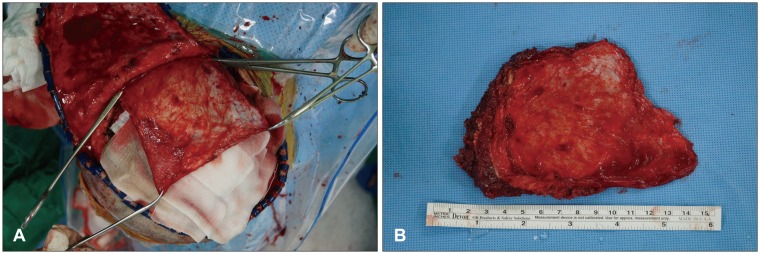Korean J Neurotrauma.
2016 Oct;12(2):84-88. 10.13004/kjnt.2016.12.2.84.
Addition of Resection of Temporal Muscle and Fascia in Decompressive Craniectomy in the Treatment of Traumatic Brain Injury
- Affiliations
-
- 1Department of Neurosurgery and Medical Research Institute, Pusan National University Hospital, Busan, Korea. csfdiver@naver.com
- KMID: 2356778
- DOI: http://doi.org/10.13004/kjnt.2016.12.2.84
Abstract
OBJECTIVE
Decompressive craniectomy (DC) is a widely used surgical procedure for control of severely increased intracranial pressure in various conditions. The goal of this study is to evaluate the effectiveness of the addition of resection of temporalis muscle and fascia in DC particularly in the treatment of traumatic brain injury.
METHODS
Twenty patients underwent temporalis muscle and fascia resection in addition to conventional DC and duroplasty due to massive brain swelling in a single tertiary hospital from 2013 to 2015 were enrolled. Twenty other patients who received the standard techniques by other neurosurgeons in the same period were gathered for the control group. Postoperative computed tomography (CT) as well as functional outcome in both groups were analyzed retrospectively.
RESULTS
CT volumetry showed a significant increase of 85.19 mL (p<0.001) of extracranial herniation volume in the research group compared with the control group. Using modified Rankin Scale and Glasgow Outcome Scale, there was no statistically significant difference in functional outcome between the two groups.
CONCLUSION
Although preliminary, the procedure appears to show a meaningful increase in extracranial herniation volume with minimal masticatory and cosmetic impairment.
MeSH Terms
Figure
Cited by 2 articles
-
Decompressive Craniectomy in Traumatic Brain Injury: A Review Article
Ji Won Moon, Dong Keun Hyun
Korean J Neurotrauma. 2017;13(1):1-8. doi: 10.13004/kjnt.2017.13.1.1.Relationship between Clinical Outcomes and Superior Sagittal Sinus to Bone Flap Distance during Unilateral Decompressive Craniectomy in Patients with Traumatic Brain Injury: Experience at a Single Trauma Center
Hyuk Ki Shim, Seung Han Yu, Byung Chul Kim, Jung Hwan Lee, Hyuk Jin Choi
Korean J Neurotrauma. 2018;14(2):99-104. doi: 10.13004/kjnt.2018.14.2.99.
Reference
-
1. André C, Py Mde O, Niemeyer-Filho P. Temporal muscle haematoma as a cause of suboptimal haemicraniectomy: case report. Arq Neuropsiquiatr. 2003; 61:682–686. PMID: 14513181.
Article2. Brain Trauma Foundation. Management and prognosis of severe traumatic brain injury. J Neurotrauma. 2000; 24:S1–S106.3. Choudhry OJ, Christiano LD, Arnaout O, Adel JG, Liu JK. Reconstruction of pterional defects after frontotemporal and orbitozygomatic craniotomy using Medpor Titan implant: cosmetic results in 98 patients. Clin Neurol Neurosurg. 2013; 115:1716–1720. PMID: 23619535.
Article4. Fehrenbach MJ, Herring SW. Illustrated anatomy of the head and neck. ed 4th. Philadelphia, PA: Saunders;2011.5. Feng J, Yang C, Cui W. Effectiveness of digital three-dimensional titanium mesh in repairing skull defect under temporalis and reconstructing temporal muscle attachment points. Zhongguo Xiu Fu Chong Jian Wai Ke Za Zhi. 2014; 28:597–600. PMID: 25073280.6. Gibbs CH, Mahan PE, Lundeen HC, Brehnan K, Walsh EK, Sinkewiz SL, et al. Occlusal forces during chewing--influences of biting strength and food consistency. J Prosthet Dent. 1981; 46:561–567. PMID: 6946223.
Article7. Huang X, Wen L. Technical considerations in decompressive craniectomy in the treatment of traumatic brain injury. Int J Med Sci. 2010; 7:385–390. PMID: 21103073.
Article8. Joo SP, Kim TS, Moon HS. How to minimize ischemic complication related to swollen temporalis muscle following indirect revascularization surgery in moyamoya disease: a technical report. J Neurol Surg A Cent Eur Neurosurg. 2014; 75:231–235. PMID: 23532610.
Article9. Kakar V, Nagaria J, John Kirkpatrick P. The current status of decompressive craniectomy. Br J Neurosurg. 2009; 23:147–157. PMID: 19306169.
Article10. Kim DH, Ko SB, Cha JK, Hong KS, Yu KH, Heo JH, et al. Updated Korean clinical practice guidelines on decompressive surgery for malignant middle cerebral artery territory infarction. J Stroke. 2015; 17:369–376. PMID: 26438005.
Article11. Maas AI, Dearden M, Teasdale GM, Braakman R, Cohadon F, Iannotti F, et al. European Brain Injury Consortium. EBIC-guidelines for management of severe head injury in adults. Acta Neurochir (Wien). 1997; 139:286–294. PMID: 9202767.
Article12. Martin AG, Abdullah JY, Jaafar A, Ghani AR, Rajion ZA, Abdullah JM. Addition of zygomatic arch resection in decompressive craniectomy. J Clin Neurosci. 2015; 22:735–739. PMID: 25564264.
Article13. Missori P, Paolini S, Ciappetta P, Seferi A, Domenicucci M. Preservation of the temporal muscle during the frontotemporoparietal approach for decompressive craniectomy: technical note. Acta Neurochir (Wien). 2013; 155:1335–1339. PMID: 23605253.
Article14. Park J, Hwang JH. Where are we now with decompressive hemicraniectomy for malignant middle cerebral artery infarction? J Cerebrovasc Endovasc Neurosurg. 2013; 15:61–66. PMID: 23844349.
Article15. Park J, Kim E, Kim GJ, Hur YK, Guthikonda M. External decompressive craniectomy including resection of temporal muscle and fascia in malignant hemispheric infarction. J Neurosurg. 2009; 110:101–105. PMID: 18834267.
Article16. Park TY, Kim JH, Chang WS, Chang JW, Park YG, Jung HH. Temporal hollowing augmentation with titanium mesh after autologous cranioplasty in temporal muscle resected case: a case report. Korean J Neurotrauma. 2013; 9:154–156.
Article17. Piek J. Decompressive surgery in the treatment of traumatic brain injury. Curr Opin Crit Care. 2002; 8:134–138. PMID: 12386514.
Article18. Winn HR. Youmans neurological surgery. ed 5th. Philadelphia, PA: Saunders;2004.19. Yasuda CL, Costa AL, Franca M Jr, Pereira FR, Tedeschi H, de Oliveira E, et al. Postcraniotomy temporalis muscle atrophy: a clinical, magnetic resonance imaging volumetry and electromyographic investigation. J Orofac Pain. 2010; 24:391–397. PMID: 21197511.
- Full Text Links
- Actions
-
Cited
- CITED
-
- Close
- Share
- Similar articles
-
- Decompressive Craniectomy in Traumatic Brain Injury: A Review Article
- Paradoxical Herniation after Decompressive Craniectomy for Acute Subdural Hematoma
- Post-Traumatic Cerebral Infarction Following Low-Energy Penetrating Craniocerebral Injury Caused by a Nail
- The relationship between the serum lactate level and in-hospital mortality after decompressive craniectomy in traumatic brain Injury
- Glasgow Coma Scale Motor Score Predicts Need for Tracheostomy After Decompressive Craniectomy for Traumatic Brain Injury



